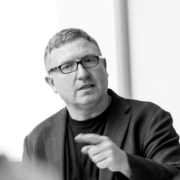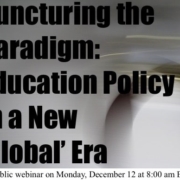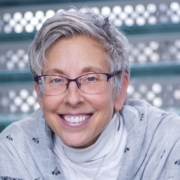Mary Mendenhall, Garnett Russell, & Elizabeth Buckner
Urban Refugees and Education
Did you know that today there are more forcibly displaced people than at any time since World War II?
The total number comes out to roughly 65 million, including internally displaced peoples, asylum seekers, and refugees. That’s roughly 1 out of every 113 people on Earth.
Today I speak with three professors from Teachers College, Columbia University about their research project on urban refugees, which is being funded by the United States Department of State’s Bureau of Population, Refugees and Migration.
At Teachers College, Mary Mendenhall is an Assistant Professor of Practice in International and Comparative Education; Garnett Russell is an Assistant Professor of International and Comparative Education; and Elizabeth Buckner is a Visiting Assistant Professor in International Comparative Education.
Below the fold, you can find some of their research photos showing urban refugee education around the world and a video presentation on the subject.
Citation: Mendenhall, Mary, Russell, Garnett and Buckner, Elizabeth, Interview with Will Brehm, FreshEd, 40, Podcast audio, September 5, 2016. https://freshedpodcast.com/marygarnettelizabeth/
Will Brehm 0:46
Mary Mendenhall, Garnett Russell and Elizabeth Buckner, welcome to FreshEd. The three of you are working on a research project looking at refugees around the world. And refugees obviously have made quite an impact on the Western media for the last few years. And we usually see pictures of UN refugee camps, or these boats filled with refugees trying to cross the Mediterranean trying to get into Europe, or even many refugees trying to get into Australia. Can you explain why these images don’t actually portray the reality of most refugees?
Mary Mendenhall 2:41
Yes, thanks for the question. While the refugee flows into Europe and other countries are being covered by the media -and it’s interesting that our study is happening kind of amidst all of this media coverage, and really helping to bring more attention to their plight- I think for those of us who’ve been working on these issues for some time, it’s simultaneously interesting and frustrating because it only tells part of the story. So, I think it’s important to recognize that we currently have the highest number, on record, of forcibly displaced people since World War Two. And that estimate currently is about 65.3 million people. And of that kind of global figure, over 21 million of these individuals are refugees, meaning they’ve crossed national borders. More than 40 million are internally displaced persons, what we would call IDPs within their own countries, and several millions more, who would be considered stateless and not recognized as belonging to a particular country. The part that’s missing from the media story is that 86% of those displaced are actually going to neighboring and what we would consider, quote unquote, developing countries in the global South, where it is assumed and I think hoped that it will be a temporary stay compared to those being resettled to Europe, Australia, Canada or the US. So, while many refugees still do reside in camps and kind of settlement settings, it’s also really important to point out in this larger story that there’s a huge trend of urbanization globally, and that this affects and applies to refugees as it does other immigrant populations. And we’re finding that more than half of all refugees are now living in urban settings so, a huge demographic shift over the years there. And I think part of the story too, there are two more important facts to point out, particularly important in terms of the impact on education. So, the first is that the average duration of displacement is 20 years, as conflicts become increasingly protracted in nature. If you look at Somalia and Afghanistan, for example, they’re going on their third and fourth decades of displacement respectively. And so very different in terms of the nature of conflict and crisis, and how long it is in terms of being protracted. And the second important point there is that 51% of refugees are under the age of 18. So, when we think about education and the protracted nature of crisis and the young ages of those who are being displaced, it’s something that we have to look at very seriously in terms of education. So, it’s important to tell the whole story, and to tease out the similarities and differences across regions and countries. And certainly, when we began the study, we didn’t realize that it might take on even more importance given the growing media attention to the global refugee crisis this year.
Will Brehm 6:01
In a country like Syria, where many people are fleeing the country for safety, or for other reasons, most of those people that cross out of Syria are ending up in countries that are bordering Syria, that’s what you were saying. Is that most of the refugees are going to neighboring countries. So, what sort of neighboring countries would that be for Syria?
Mary Mendenhall 6:27
So, for Syria, there are a number of neighboring countries but the ones that are taking the bulk of the Syrian refugees, as you’ll see and learn more through our study, are Lebanon, Jordan, Turkey, and also Iraq.
Will Brehm 6:43
And they’re taking a huge number of refugees compared to say, countries in Europe or America or even Japan, where I live?
Mary Mendenhall 6:52
Correct. I mean, the interesting thing about the coverage is that many of the refugees that are being talked about in terms of coming into Germany, or going into Australia, or Canada, or the US, or Japan, they’re coming through very formal resettlement procedures. And they’re being essentially permanently relocated to those new host countries, which is very different from the refugees that are going into Jordan and Iraq and Turkey, for example. For the larger Syrian refugee crisis, the situation is different. Those refugees are deciding to leave and cross the borders. It’s not something that’s being facilitated by the neighboring governments. So, the process through which they’re moving across borders is very different. And the way they’re being received in the countries of asylum are very different. So, that’s an important distinction to make.
Will Brehm 7:45
That’s right. And it seems like that sort of movement of people across borders, in more of the informal way, creates a huge amount of pressure on those countries that are receiving thousands and hundreds of thousands of people. But before we get into some of those pressures, specifically on education, I just wanted to know which countries is your study looking at?
Garnett Russell 8:13
I’ll tell you a bit about our study. We did a multi country study and that included both a global survey of 16 different countries across the global South, and those countries included Pakistan, Malaysia, Iran, Jordan, Lebanon, Turkey, Egypt, Sudan, South Africa, Kenya, Cameroon, Uganda, Ecuador, Venezuela, Costa Rica, and Panama. And we selected countries with the highest proportion of an urban refugee population. So, meaning, the highest number of urban refugees out of the total refugee population. And then we stratified this to represent four different regions. So, the Middle East, Africa, Latin America, and the Caribbean, and Asia. And we also selected countries to represent a range of approaches to providing education to urban refugees, and also a range of legal frameworks. So, some countries are signatories to the 1951 Refugee Convention, others have not signed it, some have reservations. And, as Mary mentioned previously, we decided to focus on the global South because the majority of refugees are actually in these neighboring countries. So, in low and middle-income countries closer to conflicts rather than the more developed OECD countries. And these countries are generally more dependent on international aid through UNHCR or international NGOs and local NGOs to provide educational services. So, after we did this global survey, we then followed up with three country case studies and we used the case studies to gather more in-depth information through interviews with stakeholders namely, UN officials and NGOs. And we also visited schools. So, in our survey, we surveyed 190 different respondents. So, we have a pretty good range. And then in the case studies, we interviewed approximately 28 to 30 different people in each of the three countries. So, the three countries that we chose were Ecuador, Kenya, and Lebanon. And again, we wanted to have three different cases to represent different approaches to providing education, different types of crises and conflicts, and different legal frameworks. So, just to give you an example, in Ecuador, the majority of refugees are Colombian -98%. And they are fleeing the protracted civil war in Colombia which doesn’t receive as much media attention because it’s been going on for decades. In Kenya, you have a very diverse and heterogeneous population from different conflicts in the region, Somalia, South Sudan, Ethiopia, Burundi, Rwanda, etc. And then in Lebanon, of course, you have the majority of Syrian refugees -so approximately 1.5 million, so the highest per capita of refugees. And there are also Palestinian refugees but that’s sort of beyond the scope of this particular study. So, basically, we looked at differences in these three cases, and how they are addressing the issue of the provision of education. So, we also saw variation in terms of the extent to which they integrate students into their local government schools or into community-run schools or non-formal, or NGO schools, which we will tell you a bit more about when we get to our findings.
Will Brehm 12:12
Having such large numbers of people flooding into different countries must cause huge problems for governments, for social services. What sort of issues have you found that governments face when it comes to refugees and education?
Elizabeth Buckner 12:32
So, it goes without saying that the specifics often depend on the host country, the number of refugees that they have, and where these refugees are from. And it also depends on the host countries reception to the refugees. Specifically, if they have camps, or if there are no camps. And so, when there are camps, and we can speak to, for example, in Kenya, there are large camps and with the Syrian response there are camps in both Turkey and Jordan. But there are not any in Lebanon. And so, when there are camps, schools can often be set up and run entirely in these camps. And there are a lot of actors who might be involved including the UN agencies, or NGOs that can step in and set up camps. But when refugees are living in urban areas, it presents some more challenges, more complexity for governments. And so, I think the big question really is where will these refugees in urban areas go to school? And so, for many governments, the pressing question is really, how can we get children, many of whom have been out of school for years even or who’ve had their schooling interrupted, how do we get them back into schools? And so, for host governments, there are really a bunch of related policy questions that have to be ironed out along the way. And so, the first is simply like, will they be allowed into public schools? And in many countries, especially signatories to the 1951 Convention, they do open public schools to refugees. But in certain countries, they are simply not allowed in public schools at all, although this is rare, but Malaysia is a good example of one of those countries. And so, in these countries, civil society has to step up and really provide access to schooling. But then even in countries where public schools are opened to refugees, there are a bunch of other important questions and specific policies that have to be figured out such as like, what are the admissions policies? What types of documents are needed for students to actually enroll in school? How do you determine what grade a student is in? So, these are questions over grade placement. And then questions about accreditation or how will we sort of evaluate and accredit students learning? Do they have access to taking the public exams that give them a degree or a diploma, for example? And so, let me just go into a little more depth here.
So, one question is just like how many refugees can government schools absorb? It’s what we call the absorptive capacity of the public schools. So, in some countries like Jordan, and Lebanon, where there’s been a huge influx of refugees all at once, these countries really don’t have room in their public schools without opening up additional shifts. So, these are what we call double shift schools. And so, because they just don’t have enough spaces in the public schools and so they open up an afternoon shift, typically. But this, again, raises other questions such as -they often have to shorten the first shift, the morning shift- and so does this then impact the quality of education for the citizens? is one. And then there’s the question of who will teach these additional classes? Will the government hire new teachers? Or will they ask the current teachers to take on the second shift as well? Which is often really difficult and straining. And of course, who will pay for these additional teachers? And there’s really concerns that there are unintended consequences with this move to double shifts such as the quality. And so, then there’s also the question of grade placement which, throughout our case studies, we found it poses difficulties in different ways in different countries. But for example, if you just think of a refugee child, for example, who maybe in their home country they studied until grade four but then they’ve been out of school for a couple of years and they’ve forgotten a lot of what they’ve learned. And so now you have an older student, but who may be is at a grade two level of education. The question, I mean, it’s a legitimate and difficult policy question, which is, what grade should that student be placed in? Or what type of remedial education is really needed to bring them up to grade 4? And so, in Kenya, we’ve seen, for example, grade placement is a big issue with older students. Often young adults being placed into primary schools whereas Lebanon has approached this very differently, and simply does not make accommodations for over aged students and expects those students to go into accelerated learning programs, essentially, non-formal programs. They don’t really want over aged students in the same classrooms.
And so, countries will approach this question quite differently. But it’s a barrier, or it creates issues because it’s just simply often like, what is the policy? Do they have to sit for an exam and whatnot? And then it’s also important to remember that education systems are large, and they’re often complicated bureaucracies. So, governments will face these issues. Communicating information is often decided at the Ministry level and communicating that down to the local school level, and so, in some countries there are decentralization policies. This is ongoing in Kenya, for example. And also in Lebanon, there’s a lot of autonomy at the local levels. But what this means is that policies of the centralized ministry, often they’re even not communicated, or they’re not followed at the local level. So, it’s not just setting the policies, it’s also implementing them that really causes issues for countries. And then I just should add that in urban settings and non-camp settings, generally, we find that both NGOs, civil society organizations and governments face added complexity in actually reaching refugee children. First of all, because we often don’t know where urban refugees are. They are more difficult to identify, they might need more transportation. They often can’t just walk to the local school in the camp. They need buses, or whatnot, or the distances are further. And it’s also often more difficult for governments because they’re coordinating a lot of different actors. And so, governments might play a bigger role needing to coordinate civil society and local ministry offices and whatnot. And so, it’s often an added burden for government systems as well. So, it’s a lot of issues that they’re facing.
Will Brehm 19:28
It just sounds like it. I mean, have you found that this pressure that gets put unto the system of education because of such large numbers of people coming into the system, does that foster a sort of resentment against those groups of refugees coming in by the local population?
Elizabeth Buckner 19:49
I would say that, yes. I mean, it is not always the case. And I think that what -I mean let me just go back to your first question that you asked Mary. Just so you know, about 1 million Syrian refugees have requested asylum in all of Europe. And in comparison, there are more than 2 million Syrian refugees in Turkey. There’s between 1.5 and 2 million refugees in Lebanon, which has a pre-crisis population of 4 million people. And in Jordan, there are about 600,000 to a million Syrian refugees. We’re not sure exactly. But so, these countries -I mean, Lebanon, you can take, for example, as Garnett mentioned, has the highest per capita burden in the world. And these are countries that -so initially, maybe there’s a lot of understanding or sympathy, or definitely, often. There’s definitely a lot of sympathy, I would say from my experience. But there’s also, there’s also legitimate concerns over the effect of refugees on the local economy, on the use of social services. When the first shift is shortened and national citizen students or Jordanian or Lebanese students are getting fewer or less instructional time, and there’s concern over the quality of their education, then there is definitely resentment. And in some cases, we see that, for example, UN agencies or donors of all different kinds will provide materials such as backpacks and textbooks to refugee children that sometimes are not provided to the national, local populations. And that can also breed resentment because many of the communities in which urban refugees settle are also very vulnerable communities. And that’s something I think we’ll touch on later. But there are a lot of similarities between, for example, vulnerable Lebanese or vulnerable Ecuadorians and refugee children. And so, there’s often the fact that maybe refugees are seen as getting additional services that the local communities aren’t getting, can also breed resentment in some cases.
Will Brehm 22:21
So, can you describe what sort of opportunities a child would have as an urban refugee?
Mary Mendenhall 22:29
Sure. And I think Elizabeth started to touch on this a little bit. But essentially, the options for refugees run the gamut of educational opportunities similar to those for students from the host country. Something that’s interesting to point out here actually is, historically, international organizations and host country governments tried to provide refugees with access to education from their countries of origin. But this has proven, in many cases, to be very difficult given the need to have access to national curriculum materials and cross border systems that would then allow for national examinations to take place and to be recognized, and for student learning to be certified in that process. And because of the nature of conflict, and because things are essentially breaking down in the country that is affected by conflict, that is very difficult to actually have happen or to be able to sustain. So, what happens now is that students typically study the curriculum of the host country, and they take national exams in camps and cities alike. So, even in Kenya, for example, the students who are in the camps, they are in schools that are recognized by the Ministry, and they’re sitting for exams and taking exams. And so, the same thing is then happening for students in the urban centers. They are accessing public schools, taking national exams, and getting certified through the Kenyan system essentially. So, with the movement toward what we’re calling local integration, in the sense, many countries do allow refugees to enroll in public schools. And of course, this is a big success in many senses in terms of kind of the policy shift that that entails. But at the same time, the right to enroll in school does not necessarily mean schools are actually accessible, and that students are able to get in and stay in school. And so that’s an important issue to point out. And I think we’ll get into the barriers a little bit later in this conversation, hopefully. But in short, students have access to public schools, private schools, community run schools. Again, these are always kind of highly context specific. So, it depends on what’s happening in the cities around these different types of schooling options. But we do see this happening. For older students -the adolescence and youth who are amongst the displaced populations- again, depending on where they find themselves, they may have opportunities to participate in accelerated learning programs, which typically allow them to complete a full cycle of primary education in half the time. So, if the country has a six-year primary education system, they would typically be able to do it in three years. And that’s really important for students who are older, who have had disruptive education for a number of years. And it would be quite awkward to have an over aged student in kind of a lower primary grade, and that does happen. But the accelerated learning programs are meant to help mitigate that challenge. And also, to help retain older students who are put kind of below their grade level have incredibly high dropout rates. So, trying to figure out what are the range of educational programs to offer these students is really important.
Another set of programs that are often offered to refugee students, particularly adolescence and youth, are the vocational education programs. And sometimes those training programs include exposure and literacy development to offset the disruptive education that they might have already experienced. And then that is combined with skills development that would help them and their families earn a living. In our study, we’ve tried to look a little bit, it’s been hard to get a lot of information. But in some of these contexts, there are also ICT interventions. So, information- communication technologies, and leveraging technology to expand access to education. There is a program called Eneza in Kenya, that helps students get access to the Kenyan curriculum through their mobile phones with or without kind of internet or data access. And the Eneza program includes things like quizzes and homework help, and ask a teacher tool. And we’re finding that students both in and out of school are apparently able to access this program, and to try to continue their educational pursuits, even if they aren’t embedded within a formal or even private school in Kenya. And I think just another interesting point to make about the schooling options is at a global level, and we’re starting to see this in these different countries that we’re looking at for this study. But in addition to these different types of schooling options, there’s also an increasing interest to look at the entire range of educational opportunities for everyone, but including vulnerable groups like refugees, so that they can pursue early childhood through primary, secondary and tertiary education. And this is really important. Again, back to that point about the protracted nature of crisis and how long young people are finding themselves in countries of asylum. And so, the idea here is that if they’re able to continue with their studies in different forms, if and when refugees are able to return to their countries of origin, or be resettled to a third country, or truly become locally integrated, it really behooves all of us to ensure that they continue to be productive and contributing members of society. And the continued educational and vocational opportunities that are afforded to them will help them do just that.
Will Brehm 28:30
So, we’ve discussed a lot about the governmental pressures that national education systems face when they have an influx of 1,000s or millions of refugees. What sort of effects do refugee children -children that cross borders and enter school systems that are foreign to them- what sort of effects do you see happening to the children involved in this movement?
Mary Mendenhall 29:07
Yes, that’s a good question. And something that I certainly hope we’re able to kind of build on our study and look at. Because our study was looking more at governmental actors’ perspectives and the international actors’ perspectives. But I think from our own respective work, we could speak to that question a little bit. You know, certainly it’s challenging, right? Depending on their ages and what they’ve already experienced. In many cases, the trauma that they’ve seen up close and personally, what that impact is and how that kind of carries with them into the school setting. And so, kind of apart from that personal story, and their trajectory amidst displacement, which is huge and has to be kind of taken into consideration, as kids are coming into school, they’re also being asked to navigate perhaps a very new curriculum. Perhaps a very new language of instruction, teachers that are more or less prepared to actually work with them. And they may be obviously in a country that they’re not familiar with, and that their parents or extended family members may not be familiar with. And so, they’re all kind of being thrown in a kind of state of flux and trying to figure out how to access education and what the procedures and policies are for doing so. But I think what’s important to remember in many of these cases while refugee children and families are fleeing for a range of reasons because of the conflict. Whether they’re being directly targeted, or their lives or their communities are being disrupted in their homes, one of the driving forces for many of these families to flee, in addition to just being safe and being protected, and being secure, tends to be education. Families recognize how important education is to their kids’ futures. And they’re willing to take on incredible life journeys and treks across foreign territories, and into new spaces to make sure that their kids have access to education. And so, I think the kids themselves feel that. I mean, obviously, depending on how old they are, and how they’re able to make sense of what’s happening in their own countries, in their own homes. But I think that’s something that we need to continue to put in the forefront of our minds as we think about how we’re writing policies or implementing programs for these students, is that they, first and foremost, are also highly valuing, and in most cases, there are certainly exceptions to the rule, but in most cases, how much they value education.
Will Brehm 31:46
So, having studied all of these different countries around the world and the refugee crisis, or crises all around the world, what sort of recommendations are you kind of drawing in the best ways to provide education to refugees.
Garnett Russell 32:06
So, I can speak to the recommendations from our survey respondents. And tell you a little bit about what we’ve found so far. So, interestingly enough, when we asked them to name the top three recommendations, the most cited recommendation, which approximately 48% of respondents named, was to actually integrate these refugee students into public or government schools. So, this is the top policy recommendation. So, this would mean integrating them into a stable education system so that they can be placed in the appropriate grade, they can sit for exams and receive proper certification. So, interestingly, this is across the four regions that we surveyed. So, we see this in Asian countries, Latin American countries, Middle Eastern countries, and African countries. And UN agencies are more likely to suggest this than international or national NGOs. Even though most organizations think that integration is the best way to address this, they don’t necessarily see this as having access to quality or inclusive education. So, it’s not enough just to have students in the schools, but we need to sort of get at what does that mean to have them in the schools. So, we still see lots of issues in terms of discrimination and xenophobia. For instance, in Ecuador, even though all students, regardless of their nationality, have the right to education, these refugee students are not being integrated to the extent that one would like to see. So, another really important recommendation that approximately 30% of our respondents mentioned was to support teacher training. And this is especially important in countries in Latin America and African countries because there’s a need both to help bolster the skills of national teachers who need to accommodate refugee learners in their classrooms, but also to train refugee teachers who are working with the students in the camps or in the community-run schools. And in addition, this also includes things like psychosocial support, or second language support, or transitioning to the host country curriculum. Because often there’s a gap, they don’t know how to work with these vulnerable students who’ve been fleeing conflict, or who’ve undergone very difficult circumstances. And you might be dealing with different languages as well, which is also difficult. So, we see some initiatives around teacher training for refugee teachers in Kenya. As well as a desire for more of that, especially in cases like Ecuador. And then a third commonly reported recommendation from the survey was this idea of supporting more community-run schools. So, this is another model for providing education, in addition to integrating students into government schools. A lot of NGOs and civil society actors support these community-run schools that are often run by the refugee community. And this is particularly important. We see this among Asian and the Asian contexts, and the Middle East contexts.
So, other recommendations that were mentioned in the survey were the need for advocacy and also accommodation of alternative education programs. So, this might include accelerated learning programs or bridging programs especially for those with interrupted education as Mary mentioned earlier. There are a lot of students that might be over-age, or they might not be in the correct grade placement because they’ve been out of school for several years. And then another commonly mentioned recommendation, particularly among the NGOs, was this provision of non-formal education. So, in the case of Lebanon, there’s support for these non-formal education programs that would serve as bridging programs that would allow students to then enter into the formal education. And then in Kenya, you see, there is a desire for French speaking communities to have community schools that would help them learn in French, and then eventually, possibly transition into English medium of instruction. And in Ecuador, this non-formal education, it’s more in terms of arts and theatre and sports and other approaches to integration. So, we do see in our research, a tension between formal education and non-formal education and sort of the best way to approach the problem. Whether it’s just to integrate them into the national schools, and if that’s really sufficient, given the fact that there’s overcrowding in a lot of cases, and that the quality is not always high, and that there’s a lot of discrimination and xenophobia that’s persistent. So, those were the main recommendations that came out of the survey. There’s another recommendation that came out of the case studies is more of the need for reliable and long-term funding. So, we see now, there’s this tension between seeing education as part of the development sector, and sort of thinking long-term and planning for longer term support versus humanitarian aid funding, which is usually shorter term. And a lot of countries are a bit concerned, for instance, in Ecuador, because of the peace process going on now in Colombia, they’re concerned that some of the aid might be withdrawn, even though the refugee crisis won’t necessarily end. So, a lot of the funding is now going towards the Middle East and the Syrian crisis, even though in a lot of cases, you have these protracted crises, and they still depend on this funding.
Will Brehm 38:24
So, I know you’re in the middle of your research project, but have you been able to identify future research directions when it comes to refugee education?
Elizabeth Buckner 38:36
Yes, we have a lot, actually. I think the good part of our study is, it’s just the tip of the iceberg. And it’s pointed out to a lot of directions for future research. So, one of the most important areas is, essentially, it’s easier to do research on access. It’s easier to measure how many refugees are in school but really, we also need to think about quality and learning. And there’s much more emphasis now on trying to sort of understand refugees and the quality of their learning, and retention and graduation, etc. And just generally, as donors and other international organizations are now engaged more and more in providing direct support to national education systems, as Mary mentioned, as like the policy orientation towards integrating refugees into public systems. We now want to sort of understand is that support having the desired effect in terms of both systems strengthening at the Ministry level? and then also student outcomes. Some other issues are at the policy level. We’re really trying to understand what are good practices for certifying learning and really making sure that these certifications or degrees are transferable. Because we know that refugee children are very mobile and so they may be traveling through different countries or different countries’ school systems. And there’s a lot of different options for where they eventually end up. They may stay in the host country, they may get repatriated, they may get re-settled in Europe, for example. And so, there’s a lot of questions over what type of degrees will actually allow them -what models do we have for their degrees to be transferable to those different settings? And then another area we’ve thought of that we think is an important area for future research is a comparative analysis of refugee students in so called developed countries like North America, and Europe, and Canada and Germany versus developing countries. In a lot of cases, we think that some of the issues they’re facing, such as language of instruction, for example, and integration or facing stereotypes or discrimination might actually be very similar. And so, there’s a lot we can learn from a comparative analysis of these different countries.
Will Brehm 41:19
It sounds like a very full research agenda going forward. So, Mary, Elizabeth, and Garnett, thank you so much for joining FreshEd today. It was really, really fun to talk.
Mary Mendenhall 41:29
Thanks for having us.
Elizabeth Buckner 41:30
Yes, it’s been great. Thanks.
Garnett Russell 41:32
Thank you.
Coming soon!
-
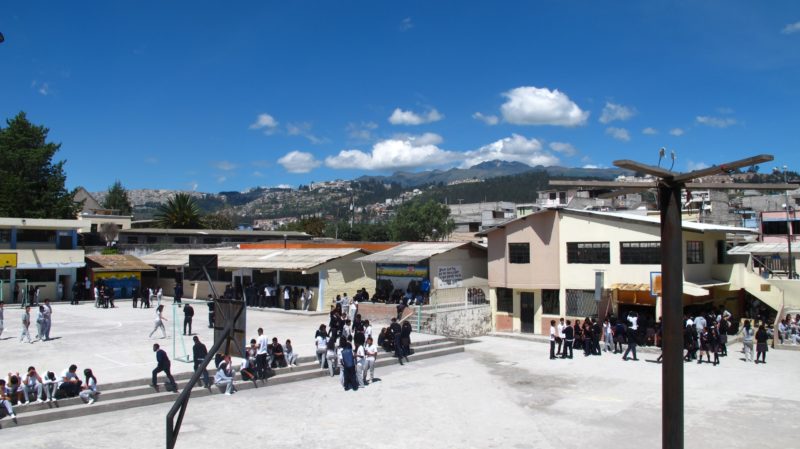
- A school in Ecuador © S. Garnett Russell
-

- NGO-run school program in an informal tented settlement in the Beqaa Valley, Lebanon © Elizabeth Buckner
-

- NGO-run school program in Beirut area © Elizabeth Buckner
-
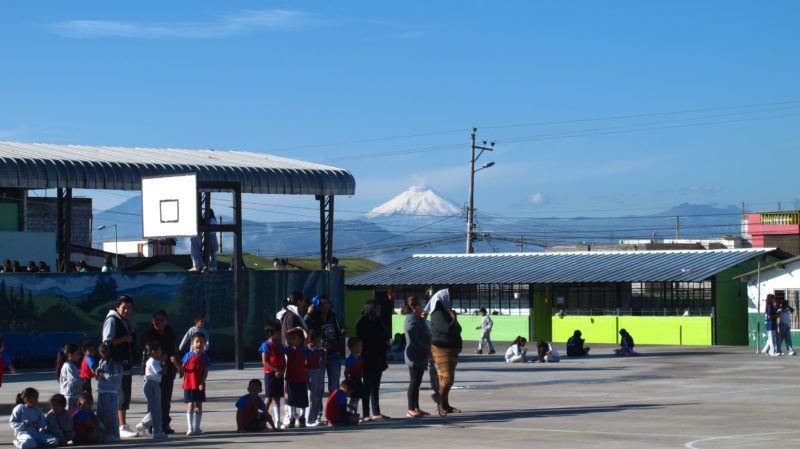
- A school in Ecuador © S. Garnett Russell
-
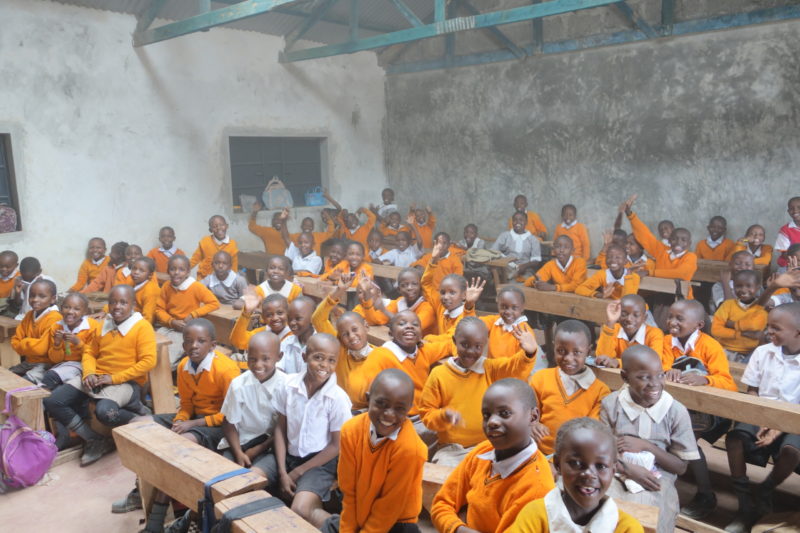
- Public/government school in Nairobi © Mary Mendenhall




